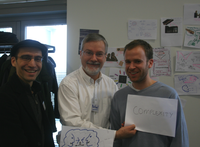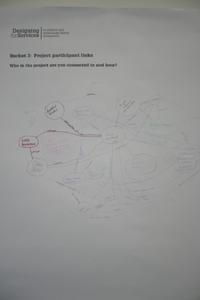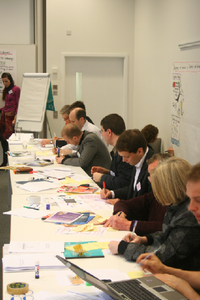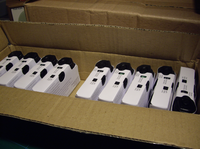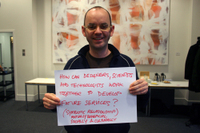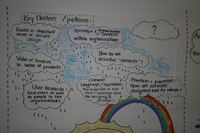
This project aims to answer three broad questions which are:
(1) How do service-based science and technology entrepreneurs’ ideas about the designing of services change once they are exposed to service design thinking and methods?
(2) How do service designers’ ideas about the designing of services change once they are exposed to research by academics involved in relevant fields such as management,
social science and IT?
(3) How do the ideas of social scientists within a business school about the designing of services change once they are exposed to service design thinking and methods?
The project sets up a number of ways of capturing at different points the ways that participants conceive of the designing of services, and creates four pairing projects between service design consultancies and science or technology enterprises offering services as a way of studying current service design methods and their effects.
In the first workshop, we created two blank posters we called "buckets" which we invited people to make notes on throughout the event. One was a bucket for research questions. Another was a bucket called a "parking lot" for parking important questions. The comments in these buckets are presented unedited here.
Parking lot bucket
⇒ What is a concept? In design, theory, social research, business etc.
⇒ Why “Services” & “Design” now?
⇒ When do we stop designing the research and start doing it? Is there a difference?
⇒ Research methods for the design of services: what is so special?
⇒ To what extent are issues and opportunities associated with this area unique and to what extent an example of / context for more generic issues of management, organisation and design?
⇒ How to establish the sci-tech “intensity” of a service? Is brain surgery really more intensive than serving burgers?
⇒ Can this research capture what it aims at by looking at a fragment of the process?
⇒ Are “services” valued by sci-tech organisations or are they “second-class citizens” i.e. a means to generate cash flow in the short-term?
⇒ Do we need to distinguish between services in sci-tech enterprises that are central or peripheral?
⇒ What is the key constraint to designing services?
⇒ Service design (& innovation) can be a very pragmatic way of creating social, financial and environmental value for businesses and their customers. My concern is that we over conceptualise the discipline and lose sight of its value
⇒ Why only sci-tech services? What characterises them and makes them complex or interesting?
⇒ What are the new ethics of service design practice?
⇒ Is “service design envy” an update on design’s concern for integrity of materials?
⇒ Does “Designing Services” need design skills or are they already being designed?
⇒ “Design” is guilty of shrouding itself in mystery and does a very good job of disguising its real value to organisations and its stakeholders. Is it a useful term for this project or does it make more problems than it solves? And what can we do to minimise the confusion around it and demystifying it in this context?
Research questions bucket
⇒ What are the language constraints & new language frameworks are needed to communicate between design, business, science & academia?
⇒ What is a “service”? How do you “design” one?
⇒ What is the term, sentence, evidence or unit that will eventually clearly communicate the value of designing services?
⇒ How do service design processes design, mobilise & enact “users”?
⇒ What is the architecture or framework that enables the provision & iteration of service provision? What “ideas” do you expose sci-tech companies to as they move towards a services environment? Can you replicate this architecture in time and place?
⇒ Are existing methods or methodologies ideal – or even adequate – for investigating the questions above?
⇒ What is the role of computer-aided design in designing for services?
⇒ What is the role/scope of complexity research methods in designing of services?
⇒ Is “design” conceived of as something like a ‘discipline’ within both academic and commercial institutions – equivalent to engineering – or is it something else and conceived of as something else?
⇒ Why and how is there something to learn from the design disciplines as concerns service innovation?
⇒ Are there “parts” of services that cannot be designed or is 100% of services designed? Designable?
⇒ To what extent do techniques for designing physical products translate to designing services?
⇒ Do interaction design methods and techniques developed by industrial designers help them to work on service design projects with other disciplines/stakeholders?
⇒ Do methods & techniques used for the design of product/service systems for sci-tech companies work for public sector services?


